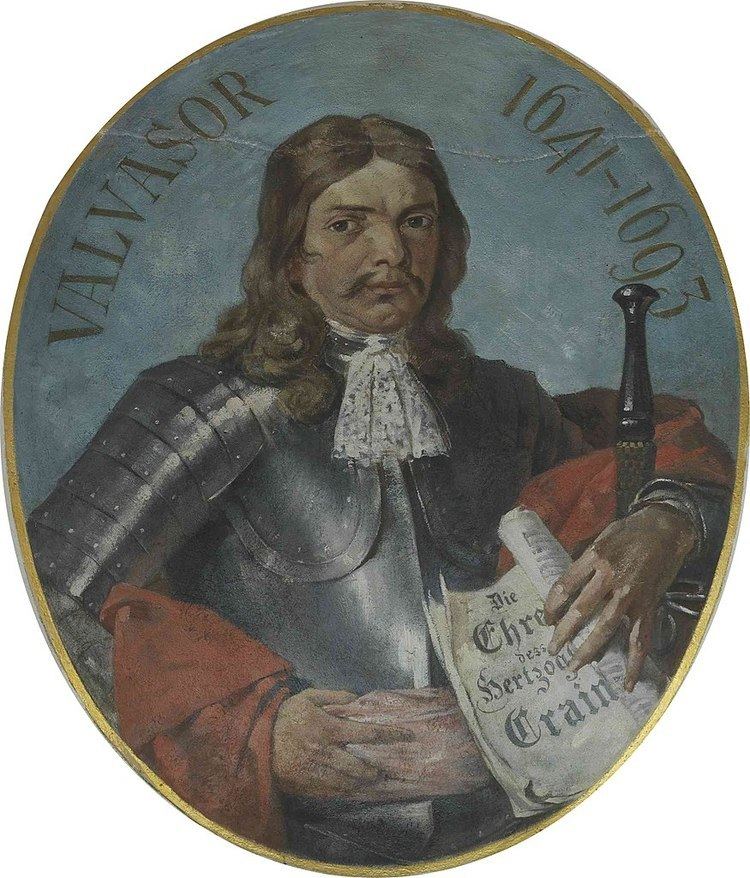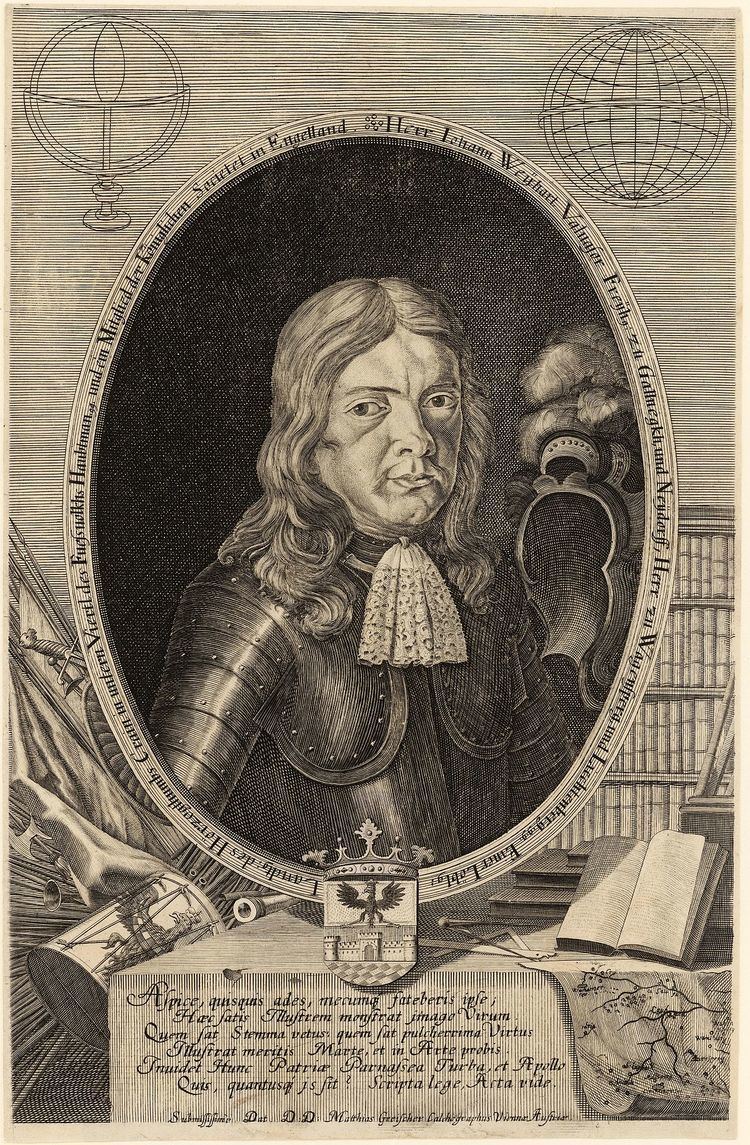Name Johann von | Role Historian | |
 | ||
Spouse Anna Rosina Valvasor (m. 1672–1687) Children Ana Rosita von Valvasor, Janez Gottlieb von Valvasor Books The Glory of the Duchy of Carniola, Topographia ducatus Carnioliae modernae 1679: 12 selected images Parents Anna Maria Freiin von Rauber, Bartholomaus von Valvasor People also search for Anna Rosina Valvasor | ||
Johann Weikhard von Valvasor
Johann Weikhard Freiherr von Valvasor or Johann Weichard Freiherr von Valvasor (Slovene: Janez Vajkard Valvasor, [ˈʋáːlʋazɔɾ]) or simply Valvasor (baptised on 28 May 1641 – September or October 1693) was a natural historian from Carniola, present-day Slovenia, and a fellow of the Royal Society in London.
Contents
- Johann Weikhard von Valvasor
- Biography
- The Glory of the Duchy of Carniola
- Karst research
- Works
- References

He is known as a pioneer of study of karst phenomena. Together with his other writings, until the late 19th century his best-known work—the 1689 Glory of the Duchy of Carniola, published in 15 books in four volumes—was the main source for older Slovenian history, making him one of the precursors of modern Slovenian historiography.
Biography
Valvasor was born in the town of Ljubljana, then Duchy of Carniola, now the capital of Slovenia. In the 16th century, It was Johann Baptist Valvasor who established the family Valvasor in the Duchy of Carniola in central Europe in a part of Austria that is now the Republic of Slovenia. In medieval Latin "Valvasor" or "Valvasore" held the meaning "the carrier of the feud". In western Europe its use can be traced back to the 11th century.
Neither the exact day nor the actual place of Valvasor's birth are known, but his baptism was registered at Ljubljana Cathedral. He was the twelfth child born to Bartholomäus and Anna Maria Freiin von Rauber, who did not only live at their Medija Castle in Izlake but also had a town residence in Ljubljana at Old Square. His godparents were Freiherr (Baron) Konrad Ruess von Ruessenstein from the Strmol Castle and Regina Dorothea Rasp from the Krumperk Castle.
Valvasor's father died when the boy was ten years old. His mother died when he was 16. At the time he was attending the Jesuit school in Ljubljana. Graduating in 1659 at the age of seventeen, he did not choose to continue his studies at a university but decided to broaden his horizons by meeting learned men on a journey across Europe. This journey lasted fourteen years and it even took him to northern Africa. During this period, he joined the army in the Austrian-Turkish War, where he became closely acquainted with the conditions on the Croatian Military Frontier.
Shortly after marrying Anna Rosina Grafenweger in 1672, Valvasor acquired the Bogenšperk Castle near Litija, where he arranged a writing, drawing and printing workshop. Valvasor spent a fortune on the publishing of his books; towards the end of his life, his debts forced him to sell Bogenšperk Castle, his vast library and his collection of prints. In 1690, Aleksandar Ignacije Mikulić, the Bishop of Zagreb, bought his library, along with some 7300 graphics, and moved it to Slavonia, where the collection became part of the library of the Zagreb Archbishopric, now part of the Croatian State Archives. Valvasor died in September 1693 in Krško.
The Glory of the Duchy of Carniola
Valvasor's most important work remains The Glory of the Duchy of Carniola (original title: Die Ehre deß Herzogthums Crain, Slovene: Slava vojvodine Kranjske), published in 1689 in 15 tomes, totalling 3532 pages and including 528 illustrations and 24 appendices, which provides a vivid description of Carniola at the time. He also recorded the first written document on vampires when he wrote on the legend of a vampire in Istria named Jure Grando.
From 2009 until 2012, it was translated into Slovene by Doris, Primož and Božidar Debenjak. The initiator, project manager, editor and technical editor of this monumental publishing project was Tomaž Čeč.
Karst research
Valvasor was a pioneer of study of karst phenomena. Upon the proposal of Edmond Halley, who was not only an astronomer but also a geophysicist, and in 1687 his extensive treatise on the hydrology of the intermittent Lake Cerknica won him a Fellowship of the Royal Society.
